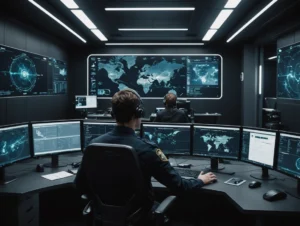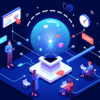The modern workplace is undergoing a profound transformation, driven by the rapid advancement of artificial intelligence. We are moving beyond tools that simply assist us to the emergence of true AI agents—sophisticated systems capable of autonomous reasoning, decision-making, and task execution. This shift heralds a new era of collaboration, where humans and AI agents work side-by-side as integrated teammates. This article explores the integration of these digital coworkers, examining their rise, operational roles, the synergy they create with human teams, and the future of these augmented intelligence units, complete with practical examples of how these partnerships function in real-world scenarios.
The Rise of AI Agents in the Workplace
The infiltration of AI into business operations began with simple automation tools designed for repetitive, rule-based tasks. However, the advent of large language models (LLMs) and advanced machine learning algorithms has catalyzed a leap from passive automation to active agency. An AI agent is distinguished by its ability to perceive its environment, make decisions based on those perceptions, and execute actions to achieve a defined goal, often with a degree of autonomy that was previously unimaginable for software.
This rise is fueled by several converging factors. The exponential growth in computational power and the availability of vast datasets provide the necessary fuel for training complex models. Simultaneously, the development of robust frameworks and APIs has democratized access to powerful AI, allowing organizations of all sizes to integrate agentic capabilities into their existing software ecosystems without building models from scratch.
The economic imperative is also undeniable. In a competitive global market, businesses are relentlessly pursuing efficiency, innovation, and scalability. AI agents offer a path to achieve these goals by augmenting human capacity, reducing operational latency, and enabling 24/7 productivity. They are not just a technological upgrade but a strategic asset for reshaping business models and creating new value propositions.
We see early manifestations in customer service chatbots that can now resolve complex issues without human intervention, and in virtual assistants that manage schedules, prioritize emails, and draft communications. These are the precursors to more advanced agents that will manage projects, conduct research, and even drive strategic initiatives.
The trajectory is clear: AI agents are evolving from niche tools to ubiquitous coworkers. Their integration is becoming a key differentiator, separating forward-thinking organizations from those that risk being left behind. This is not a distant future scenario; it is a present-day reality that is accelerating at a remarkable pace.
Understanding this rise is the first step in preparing for a workplace where human intelligence and artificial intelligence are fundamentally intertwined. The question is no longer if these agents will become colleagues, but how we will collaborate with them effectively and ethically.
Integrating AI Agents into Human Teams
Successful integration of an AI agent into a human team is a nuanced process that goes far beyond mere technical implementation. It requires a deliberate strategy focused on role definition, trust-building, and cultural adaptation. The first critical step is to clearly articulate the agent’s purpose: Is it an assistant, an expert, an orchestrator, or an automator? This clarity prevents role ambiguity and sets realistic expectations for both the AI and its human teammates.
Establishing trust is paramount. Unlike traditional software, AI agents operate with probabilistic outputs, meaning their responses can vary and sometimes be incorrect. Teams must develop a calibrated trust—a understanding of the agent’s strengths and limitations. This is often achieved through transparent operation; agents should be designed to explain their reasoning, cite their sources, and express confidence levels for their outputs.
# Example: An AI agent providing a confidence score with its analysis
def analyze_market_trend(data):
analysis, sources = agent_reasoning_engine(data)
confidence_score = calculate_confidence(analysis, sources)
if confidence_score < 0.7:
return f"Analysis: {analysis}. (Confidence: Low - {confidence_score}. Please review with human expert.)"
else:
return f"Analysis: {analysis}. (Confidence: High - {confidence_score}. Sources: {sources})"
# This prompts appropriate human oversight for low-confidence outputs.The technical integration must be seamless. AI agents should plug into existing communication and project management tools (like Slack, Teams, or Jira), acting as a natural participant in workflows. They need appropriate access permissions to data sources and systems to perform their duties, all while adhering to strict security and privacy protocols.
Change management is a crucial, often overlooked, component. Human team members may fear job displacement or feel skeptical about relying on a machine. Leadership must communicate the vision of augmentation—that the AI is there to handle tedious tasks, thus freeing humans to focus on higher-value work that requires creativity, empathy, and strategic thinking. Training sessions should be conducted to familiarize the team with the agent’s capabilities and interaction protocols.
Finally, a feedback loop is essential for continuous improvement. Human coworkers must have easy channels to provide feedback on the agent’s performance, correct its mistakes, and suggest new capabilities. This collaborative refinement ensures the agent evolves to better serve the team’s needs, fostering a sense of shared ownership and partnership.
Ultimately, integration is about creating a cohesive unit. The AI agent becomes another entity on the organizational chart, with a defined role and responsibilities, contributing to the team’s collective intelligence and output.
The Operational Roles of AI Coworkers
AI agents are not monolithic; they specialize into distinct operational roles tailored to specific business functions. Understanding this taxonomy is key to deploying them effectively. One of the most common roles is that of the Expert Consultant. These agents are trained on vast domains of knowledge (e.g., legal precedents, scientific research, internal company documentation) and act as on-demand experts.
# Example: A legal consultant agent using RAG (Retrieval-Augmented Generation)
from langchain.vectorstores import Chroma
from langchain.llms import OpenAI
from langchain.chains import RetrievalQA
# Load a vector database of legal documents
vectordb = Chroma(persist_directory="./legal_db", embedding_function=embedding_function)
retriever = vectordb.as_retriever(search_kwargs={"k": 3}) # Retrieve top 3 relevant passages
# Create an Expert Consultant agent
legal_qa_chain = RetrievalQA.from_chain_type(
llm=OpenAI(temperature=0), # Use temperature=0 for factual, deterministic outputs
chain_type="stuff",
retriever=retriever,
return_source_documents=True
)
# Query the agent
query = "What is the company's liability in a slip-and-fall accident on icy premises?"
result = legal_qa_chain({"query": query})
print(f"Answer: {result['result']}")
print(f"Sources: {[doc.metadata['source'] for doc in result['source_documents']]}")Another critical role is the Process Automator. These agents execute multi-step workflows across different applications. For instance, an agent could be triggered by an emailed invoice, extract its data, enter it into an accounting system, and then message a human for approval—all without manual intervention.
The Creative Collaborator is a rapidly advancing role. These agents assist in brainstorming, drafting content, generating design mockups, and composing music. They don’t replace human creativity but rather act as a catalyst, generating a wide range of options for the human to refine, edit, and imbue with meaning and emotion.
Analytic and Data Synthesis agents are indispensable for data-driven teams. They can autonomously query databases, run complex statistical analyses, generate reports with visualizations, and even highlight anomalies or emerging trends that might escape human notice, providing actionable insights directly to decision-makers.
Finally, the Coordinator/Orchestrator role is emerging for complex projects. These agents can break down a high-level goal into subtasks, assign them to other specialized agents or humans, track progress, resolve dependencies, and ensure deadlines are met, effectively acting as an AI project manager.
By assigning clear operational roles, organizations can strategically deploy AI agents to address specific pain points, maximize their impact, and create a more efficient and capable hybrid workforce.
Fostering Synergistic Human-AI Workflows
The true power of AI agents is unlocked not when they work in isolation, but when they are woven into human workflows to create synergy—where the combined output is greater than the sum of individual efforts. Designing these workflows requires a deep understanding of the strengths of both parties: the speed, scalability, and data-processing prowess of AI, and the contextual understanding, creativity, and ethical judgment of humans.
A powerful pattern is the “Agent-Human-Agent” handoff. A workflow can begin with an AI agent conducting initial research or data gathering. It then prepares a summarized brief and hands it off to a human for strategic analysis and decision-making. The human’s decision then triggers another agent to execute the next phase of the plan.
Workflow Example: Content Creation Pipeline
1. [AI Agent] "Idea Generator": Analyzes trending topics and suggests 5 blog post ideas.
2. [HUMAN] Editor: Selects one idea and provides a rough outline and key points.
3. [AI Agent] "Drafter": Writes a first draft based on the outline.
4. [HUMAN] Writer: Edits the draft, adds nuance, voice, and expert commentary.
5. [AI Agent] "Fact-Checker & Optimizer": Verifies claims and suggests SEO keywords.
6. [HUMAN] Editor: Final review and approval for publication.Another synergistic model is AI as a Real-Time Augmenter. In this model, the AI agent operates alongside the human in real-time. For example, during a video conference, an agent could provide a live transcript, summarize key points, flag action items, and even privately suggest talking points to the user based on the conversation’s flow.
Continuous feedback loops are the nervous system of a synergistic workflow. Humans must train and correct agents, and agents must, in turn, learn from this feedback to improve their future performance. This can be built directly into the interaction.
# Example: A simple feedback mechanism for an AI-generated report
def generate_report(query):
report = ai_analyst_agent(query)
print(report)
feedback = input("Was this report helpful? (Yes/No). If No, please specify what was missing: ")
log_feedback(query, report, feedback) # Log for continuous fine-tuning
if feedback.lower() != "yes":
send_alert_to_supervisor(f"Report on '{query}' required human correction.")The goal is to create a seamless dance between human and machine, where each player performs the steps they are best at. The human remains firmly “in the loop” for critical judgments and creative direction, while the agent handles the heavy lifting of information retrieval, synthesis, and repetitive task execution. This collaboration amplifies human intelligence and leads to outcomes that are both more efficient and more innovative.
The Future of Augmented Intelligence Teams
The evolution of human-AI collaboration is poised to accelerate, leading us toward truly integrated augmented intelligence teams. The next frontier will be inhabited by multi-agent systems, where teams of specialized AI agents will collaborate with each other under the gentle guidance of a human supervisor. A single prompt from a human, like “Prepare the Q3 financial report and presentation,” could trigger a coordinated effort among a data-fetching agent, an analysis agent, a visualization agent, and a drafting agent.
We will see the rise of more affective and context-aware agents. Future AI coworkers will better understand human emotion, tone, and complex social contexts within an organization. They will be able to adapt their communication style, know when to interrupt and when to remain silent, and even contribute to improving team morale by recognizing signs of stress or burnout.
Embodied AI will bring agents into the physical workspace. Rather than being confined to servers and screens, AI coworkers will inhabit robotic forms that can interact with the physical environment—restocking warehouse shelves alongside humans, performing precision tasks in labs, or assisting customers in retail spaces, all while connected to a central cognitive cloud.
The concept of personalized AI agents will become standard. Each human employee might have a dedicated primary AI agent that learns their specific preferences, working style, and strengths. This agent would act as their chief of staff, interfacing with other specialized agents and filtering information to present only what is most relevant and critical.
# Conceptual code for a personalized agent interface
class PersonalAIAgent:
def __init__(self, user_id):
self.user_id = user_id
self.preferences = load_user_preferences(user_id) # e.g., "prefers bullet points", "avoids meetings before 10am"
self.workload_analyser = WorkloadAnalyzerAgent()
self.email_agent = EmailManagerAgent()
def start_workday(self):
urgent_emails = self.email_agent.filter_emails(priority="high")
schedule = self.workload_analyser.recommend_schedule(self.user_id)
return f"Good morning. You have {len(urgent_emails)} urgent emails. Your recommended focus for today: {schedule}"
# Initialize the agent for a specific user
my_agent = PersonalAIAgent("john.doe")
print(my_agent.start_workday())Ultimately, the future workplace will be a symbiotic ecosystem. The distinction between “human jobs” and “AI jobs” will blur, giving way to a new paradigm of “collaborative tasks.” The most sought-after human skills will be those that complement AI: complex problem-solving, creativity, leadership, and emotional intelligence. Success will be defined by how effectively a team—comprising both biological and artificial intelligence—can learn, adapt, and innovate together.
The integration of AI agents as collaborative coworkers marks a definitive shift in the architecture of work. This is not a story of replacement but one of profound augmentation and partnership. By understanding their rise, thoughtfully integrating them into teams, defining their roles, and designing synergistic workflows, we can harness their potential to eliminate drudgery, enhance creativity, and solve problems at a scale and speed previously impossible. The future belongs to augmented intelligence teams—hybrid systems that leverage the unique strengths of both human and artificial intelligence. Embracing this collaborative model is no longer merely an option for businesses seeking a competitive edge; it is fast becoming an imperative for relevance and success in the new era of work.




